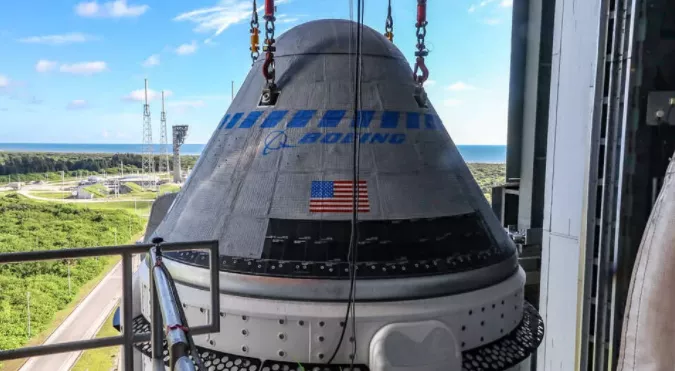It was reported on May 12 that the "Starline" manned spacecraft developed by Boeing is about to conduct unmanned flight test again. But according to people familiar with the matter, Boeing fell out with Aerojet Rocketdyne, the main supplier of spacecraft parts Boeing's CST-100 Starline spacecraft is scheduled to take off on atlas 5 rocket on May 19 local time and travel from Florida to the international space station.

The purpose of this trip is to prove to NASA that Boeing spacecraft can safely transport astronauts to and from the international space station. In 2019, a similar unmanned flight test was interrupted due to the failure of spacecraft software.
This mission is a key step in Boeing's competition with Elon Musk's SpaceX. However, according to three people who asked not to be named, the differences between Boeing and Aerojet, a propulsion system supplier, have further complicated the current situation.
In July last year, the fuel valve of the Starline spacecraft propulsion system had problems, and Boeing stopped the original launch plan. Sources said that Boeing, headquartered in Chicago, and Aerojet Rocketdyne, headquartered in El Segundo, California, have differences on the causes of the problem, and the two companies are blaming each other.
The Boeing Starline spacecraft has experienced twists and turns since its launch. The dispute with Aerojet Rocketdyne is only the latest example of a series of problems in the project. Since 2019, Boeing has spent $595 million on the Starline spacecraft project. The company signed a fixed price contract with NASA. Various unexpected circumstances led to Boeing having little room for maneuver financially. The company has been promoting the spacecraft test plan out of its own pocket.
Boeing acknowledged for the first time in a statement that it ultimately intends to redesign the fuel valve of the Starline spacecraft to prevent the problems that delayed the test flight last year. "We are making short-term and long-term design changes to the valve," Boeing said in a statement
As part of the propulsion system, the fuel valve mainly helps the spacecraft fly in space, but Boeing found that 13 of the fuel valves were closed before the spacecraft was launched without any response, resulting in the delay of the spacecraft test last year.
Various technical problems make the first manned flight test of Starline spacecraft still unknown, which makes Boeing far behind Musk's SpaceX. The latter manned dragon spacecraft has completed five manned space missions for NASA.
NASA hopes Boeing will provide more options for transporting astronauts to and from the international space station. In March this year, NASA signed three more manned space missions with SpaceX to make up for the demand gap caused by the delay of Boeing project.
Boeing and NASA engineering teams agreed that the valve stuck mainly because of the chemical reaction between propellant and aluminum and the moisture in the air at the Florida launch site.
Two sources said Aerojet Rocketdyne engineers and lawyers had different views on this. They accused Boeing of using a chemical cleaner in the ground test of the spacecraft.
A representative of Aerojet Rocketdyne declined to comment.
"Testing to determine the root cause of the valve problem has been completed," Boeing said in a statement Boeing did not find the problem described by Aerojet Rocketdyne.
Steve stich, who is in charge of Boeing and SpaceX manned space programs at NASA, said that NASA also agrees with Boeing.
Boeing also said that the design of Aerojet Rocketdyne did not meet the contract requirements, and the propulsion system was not flexible enough to resist the problems caused by chemical reactions.
Boeing pushed the Starline spacecraft back to the launch pad for the third time before its launch last week, replaced a new propulsion system and temporarily repaired the valve to prevent water from seeping into it.
Boeing and NASA said that during the nine month test, they did not reproduce the fault that the spacecraft valve was completely stuck, but measured the difficulty of opening the valve.
Two sources said that this method is to enable the Starline spacecraft to quickly return to the launch pad.
NASA, Boeing, Aerojet Rocketdyne and independent safety consultants will meet this week to make a final decision on the cause of the valve problem and determine whether the temporary repair plan is effective.
Two sources said Boeing executives privately believed that Aerojet Rocketdyne's explanation of the valve failure was to shirk responsibility and avoid paying for the redesigned valve system.
"It's ridiculous," said a person involved in a joint Boeing NASA investigation of the statement issued by Aerojet Rocketdyne. "Ask the valve manufacturer or propulsion system supplier to write 'yes, I screwed it up'... It will never happen."
After testing and software problems led to the failure of the Starline spacecraft to successfully dock with the international space station in 2019, NASA officials admitted that they trusted Boeing too much and just decided to conduct more supervision over the newly established SpaceX company.
The unhappiness with Aerojet Rocketdyne is not the first time Boeing has disagreed with its spacecraft subcontractor. In 2017, the Starline spacecraft had an accident during a ground test, resulting in the amputation of the president of another subcontractor. The subcontractor brought a lawsuit on this matter, and the two parties then reached a settlement.